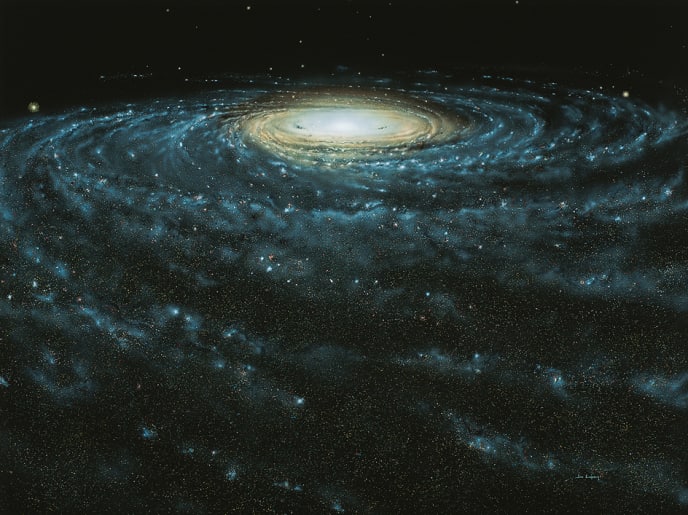Earlier this year, in April, the European Space Agency (ESA) released the second trove of data gathered by the space probe Gaia (named after the ancient Greek goddess Gaia). Gaia’s precise measurements of the position, brightness, motion, and color of over 1.3 billion stars will transform astronomers’ understanding of our galaxy, the Milky Way.
The Milky Way contains the sun, Earth, and other objects in our solar system. It also includes hundreds of billions of stars besides the sun. Huge clouds of gas and dust lie throughout the galaxy, and they constantly form new stars. The Milky Way is so massive that about 10 smaller galaxies orbit it like satellites revolving around a planet.
Because our solar system is located within the Milky Way, vast clouds of dust and dense swaths of stars prevent astronomers from determining the galaxy’s exact structure. It is a bit like trying to see the outside of one’s home from the inside. Until now, astronomers had to guess what the Milky Way looks like by observing other galaxies with similar traits—the equivalent of looking at other houses from a window. Astronomers know the Milky Way is a spiral galaxy, with long arms extending out from a central core. But no one knows how many arms it has, what kinds of stars the arms contain, or whether the galaxy is a traditional spiral or a subtype called a barred spiral galaxy where the central core is elongated.

Gaia is like a flying drone taking photos around the neighborhood. Launched in 2013 by the ESA, Gaia traveled to a point behind Earth and began measuring the positions of over a billion stars. Gaia measures stellar distances using a technique called parallax. It first images a star against a background of other stars. Halfway around the sun, it takes another picture of the same star. Because the two pictures are taken from far distant positions, the star moves slightly in relation to its background. This is the same optical effect that makes an object at arm’s length to appear to change positions when viewed from just one eye or the other. Because scientists know how far away the two star pictures were taken, and how much the star appeared to move, they can precisely calculate its distance from Earth.
Gaia’s portrait of the Milky Way also extends into the fourth dimension—time. Over the course of its five-year mission, Gaia will map the sky 29 times. From those time-lapsed maps, astronomers can determine the speed and direction in which the galaxy’s stars and gas clouds are moving through space. This information tells us the origins of Milky Way objects and can even warn of galactic collisions or violent stellar explosions. This time-based study of the galaxy is called galactic archaeology.
Gaia is gathering more than just information about stars. The second data release also had the locations of 14,000 known asteroids within our solar system, allowing astronomers to precisely map their orbits. Future data releases will map even more solar system objects.
ESA released the first Gaia dataset in 2016. For each release, scientists have raced to mine the data for new discoveries. Usually, data from such spacecraft are temporarily reserved for scientists directly associated with the mission. But mission managers have released Gaia’s data to everyone at the same time. This has led to another impressive statistic: over 1,000 peer-reviewed scientific papers that use Gaia’s data have already been written since the first data release. Many thousands more will be written before all Gaia’s insights are revealed.
Image 1: In this artist’s impression, Gaia maps the stars of the Milky Way. Credit: ESA/ATG medialab/ESO/S. Brunier
Image 2: The space probe Gaia will tell us if the Milky Way is a traditional spiral galaxy, as in this illustration, or a barred spiral galaxy with an elongated central core. Credit: Artwork © Jon Lomberg and the National Air and Space Museum